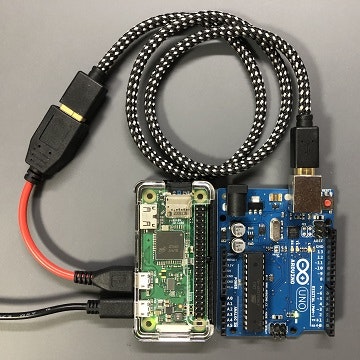1. はじめに
シリアルポートのデータ送受信ツールを作成し、Arduino治具のコマンド制御をRaspberry Piで手軽にできるようにします。
1.1 これまでの記事
2. 環境
- Raspberry Pi Zero WH Rev 1.1
- Raspberry Pi OS Lite(32-bit)
- A port of Debian Bullseye with no desktop environment
- リリース日時:2022-09-22
- Python 3.9.2(Raspberry Pi OS Liteにプリインストールされているもの)
-
PyUSB 1.2.1
- sudo pip3 install pyusb
-
pySerial 3.5
- sudo pip3 install pyserial
3. ソースコード
# mytools_pyserial.py by ka's@pbjpkas 2023
# MIT License
# on the Raspberry Pi OS(Bullseye),
# AE-TTL-232R:/dev/ttyUSB0
# Arduino UNO:/dev/ttyACM0
import serial
def main():
h = None
while True:
print("== myTools PySerial ==")
if h != None:
print("current:%s, baudrate=%d, timeout=%.1f, dsrdtr=%d" % (h.port, h.baudrate, h.timeout, h.dsrdtr))
else:
print("current:None")
print("a: open /dev/ttyUSB0, baudrate=115200, timeout=2.0, dsrdtr=False")
print("b: open /dev/ttyACM0, baudrate=115200, timeout=2.0, dsrdtr=False")
print("o: open with parameters")
print("w: write")
print("r: readline")
print("p: print settings")
print("x: exit")
s = input(">")
if s == "a":
try:
h = serial.Serial("/dev/ttyUSB0", baudrate=115200, timeout=2.0, dsrdtr=False)
except:
h = None
print("Port Not Found.")
if s == "b":
try:
h = serial.Serial("/dev/ttyACM0", baudrate=115200, timeout=2.0, dsrdtr=False)
except:
h = None
print("Port Not Found.")
if s == "o":
port = input("port? >")
baudrate = input("baudrate? >")
timeout = input("timeout? >")
dsrdtr = input("dsrdtr? 0/1>")
s = input("OK? y/n>")
if s == "y":
try:
h = serial.Serial(port, int(baudrate), timeout=float(timeout), dsrdtr=bool(dsrdtr))
except:
h = None
print("Port Not Found.")
else:
pass
if s == "w":
if h != None:
cmd = input()
cmd = cmd + "\n"
h.write(cmd.encode("shift_jis"))
if s == "r":
if h != None:
str = h.readline().strip().decode("utf-8")
print(str)
if s == "p":
print(h)
if s == "x":
if h != None:
h.close()
if __name__ == "__main__":
print("Bye.")
return
if __name__ == "__main__":
main()
4. 使い方
sudoを付けて実行します。
sudo python3 mytools_pyserial.py
以下のようにメニューとプロンプト(>)が表示されればOKです。
== myTools PySerial ==
current:None
a: open /dev/ttyUSB0, baudrate=115200, timeout=2.0, dsrdtr=False
b: open /dev/ttyACM0, baudrate=115200, timeout=2.0, dsrdtr=False
o: open with parameters
w: write
r: readline
p: print settings
x: exit
>
4.1 シリアルポートのオープン
Raspberry PiにArduinoを接続すると/dev/ttyACM0で認識されます。"b"を選択するとポート:/dev/ttyACM0、ボーレート:115200、タイムアウト:2.0秒、DSRDTR:Falseでシリアルポートをオープンします。エラーなくオープンするとメニューのcurrentの行にシリアルポートの情報が表示されます。
>b
== myTools PySerial ==
current:/dev/ttyACM0, baudrate=115200, timeout=2.0, dsrdtr=0 ←シリアルポートの情報
a: open /dev/ttyUSB0, baudrate=115200, timeout=2.0, dsrdtr=False
b: open /dev/ttyACM0, baudrate=115200, timeout=2.0, dsrdtr=False
o: open with parameters
w: write
r: readline
p: print settings
x: exit
>
"o"を選択するとパラメータを任意に設定してオープンします。
>o
port? >/dev/ttyACM0
baudrate? >115200
timeout? >2.0
dsrdtr? 0/1>1
OK? y/n>y
== myTools PySerial ==
current:/dev/ttyACM0, baudrate=115200, timeout=2.0, dsrdtr=1
(メニューは省略、以下同)
4.2 コマンド送信
Arduinoへコマンド"ver"を送信する例です。
>w
ver
4.3 コマンド受信
verの戻り値を受信する例です。"r"を選択するたびに受信データを1行ずつ表示します。受信データが空の場合はタイムアウトしてメニューに戻ってきます。
>r
This is C:\Users\hoge\Documents\Arduino\ArduinoTools\ArduinoTools.ino Build at Dec 17 2022 12:11:10
>r
OK
>r
4.4 シリアルポート設定値の表示
"p"を選択すると設定値が表示されます。
>p
Serial<id=0xaabe7e68, open=True>(port='/dev/ttyACM0', baudrate=115200, bytesize=8, parity='N', stopbits=1, timeout=2.0, xonxoff=False, rtscts=False, dsrdtr=False)
4.5 exit
"x"を選択すると"Bye."を表示して終了します。
>x
Bye.
5. mytools.pyへの組み込み
5.1 mytools.pyの改修
mytools.pyを3か所編集します。
# myTools.py by ka's@pbjpkas 2023
# python 3.x
# MIT License
import sys
import cv2
import mytools_visa
import mytools_pyserial # 1.mytools_pyserialをimportする
#(略)
def main():
while True:
print("== myTools ==")
print("a: comparison of old and new value")
print("b: crop image")
print("c: VISA menu")
print("d: Serial menu") # 2.メニューにSerial menuを追加する
print("x: exit")
s = input(">")
if s == "a":
comparison_value()
if s == "b":
crop_image_menu()
if s == "c":
mytools_visa.main()
if s == "d":
mytools_pyserial.main() # 3.mytools_pyserial.main()を呼び出す
if s == "x":
print("Bye.")
sys.exit()
5.2 実行例
sudoを付けて実行します。
sudo python3 mytools.py
メニューにSerialメニューが追加されています。
== myTools ==
a: comparison of old and new value
b: crop image
c: VISA menu
d: Serial menu
x: exit
>
6. おわりに
Arduino治具のコマンド制御をRaspberry Piで手軽にできるようになりました。
